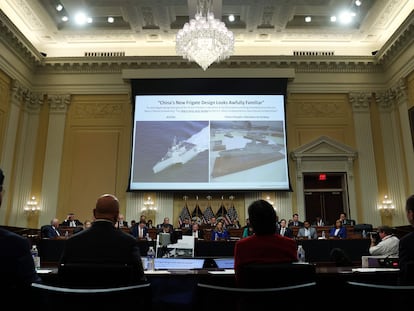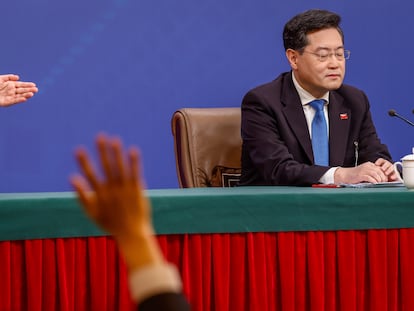Philippines launches strategy of publicizing Chinese actions
Manila’s coast guard has intensified patrols in the disputed South China Sea and taken extra efforts to document and publicize assertive Chinese behavior in the strategic waterway

The Philippine coast guard has launched a strategy of publicizing aggressive actions by China in the disputed South China Sea, which has countered Chinese propaganda and sparked international condemnation that has put Beijing under the spotlight, a Philippine official said Wednesday.
Manila’s coast guard has intensified patrols in the disputed waters and taken extra efforts to document and publicize assertive Chinese behavior in the strategic waterway, including a Feb. 6 incident in which a Chinese coast guard ship aimed a military-grade laser that briefly blinded some crew members on a Philippine patrol boat off a disputed reef.
The coast guard protested and released a video of the incident, which sparked alarm in the Philippines, the United States and some other Western countries. President Ferdinand Marcos Jr. summoned China’s ambassador to Manila and later said the Philippine military has shifted its focus from fighting Muslim and communist insurgents and other internal threats to external defense amid long-seething South China Sea territorial disputes.
“I’d like to emphasize that the best way to address Chinese ‘gray zone’ activities in the West Philippine Sea is to expose it,” coast guard Commodore Jay Tarriela said, referring to China’s use of ostensibly civilian fishing and research vessels to perform military tasks to avoid a military response from rival claimant states.
Tarriela used the Philippine name for the stretch of the South China Sea close to its western coast. He spoke at a Manila forum about China’s “gray zone” operations in the disputed sea.
The Philippine coast guard’s role as a mouthpiece against Chinese aggression “allows like-minded states to express condemnation and reproach which puts Beijing in a spotlight,” he said. “Chinese actions in the shadows are now checked, which also forced them to come out in the open or to publicly lie.”
Tarriela said Manila’s outrage over the laser-pointing incident prompted China, including its ambassador to Manila, to explain its position when asked about the incident at news conferences.
Chinese officials said the Philippine patrol vessel trespassed into Chinese territory and that the Chinese coast guard acted “professionally and with restraint” and used a harmless laser to track the Philippine boat’s movement.
By making public unedited coast guard videos and photographs of such Chinese actions, “we can once again reshape public opinion to weigh things objectively based on facts and not just propaganda,” Tarriela said.
The US State Department reacted to the incident by saying that China’s “dangerous operational behavior directly threatens regional peace and stability” and “undermines the rules-based international order.” It renewed a warning that it would defend the Philippines, a treaty ally, if Filipino forces, aircraft and ships come under attack in the South China Sea.
Raymond Powell, a retired US Air Force colonel who has studied China’s strategies, praised the Philippine coast guard’s efforts to publicize China’s actions in the South China Sea but warned that the Philippine government would come under Chinese pressure to “stop making so much trouble, stop releasing things.”
China claims virtually all of the South China Sea, putting it on a collision course with other claimants such as the Philippines, Vietnam and Malaysia.
Despite friendly overtures to Beijing by former Philippine President Rodrigo Duterte and his successor, Marcos Jr., who visited Beijing and met President Xi Jinping in January, tensions have persisted, resulting in a strengthening of the military alliance between the Philippines and the US.
Sign up for our weekly newsletter to get more English-language news coverage from EL PAÍS USA Edition
Tu suscripción se está usando en otro dispositivo
¿Quieres añadir otro usuario a tu suscripción?
Si continúas leyendo en este dispositivo, no se podrá leer en el otro.
FlechaTu suscripción se está usando en otro dispositivo y solo puedes acceder a EL PAÍS desde un dispositivo a la vez.
Si quieres compartir tu cuenta, cambia tu suscripción a la modalidad Premium, así podrás añadir otro usuario. Cada uno accederá con su propia cuenta de email, lo que os permitirá personalizar vuestra experiencia en EL PAÍS.
¿Tienes una suscripción de empresa? Accede aquí para contratar más cuentas.
En el caso de no saber quién está usando tu cuenta, te recomendamos cambiar tu contraseña aquí.
Si decides continuar compartiendo tu cuenta, este mensaje se mostrará en tu dispositivo y en el de la otra persona que está usando tu cuenta de forma indefinida, afectando a tu experiencia de lectura. Puedes consultar aquí los términos y condiciones de la suscripción digital.
More information

Biden expected to tighten rules on US investment in China
Archived In
Últimas noticias
All the effects of gentrification in one corner of Mexico’s Colonia Roma
Palestinian reporter Youmna El Sayed: ‘My family told me I had to choose between being a journalist or a mother’
The new language of the workplace: Knowing how to ask AI questions is more important than using it
Russell Tovey: ‘I was advised many times not to come out, I don’t think there was many people who’d done that — and I feel really proud that I’m one of those that did’
Most viewed
- The low-cost creative revolution: How technology is making art accessible to everyone
- Christian Louboutin: ‘Young people don’t want to be like their parents. And if their parents wear sneakers, they’re going to look for something else’
- US sanctions against jailed cartel leader ‘El Marro’ highlight Mexico’s lack of control over its prisons
- Liset Menéndez de la Prida, neuroscientist: ‘It’s not normal to constantly seek pleasure; it’s important to be bored, to be calm’
- ‘El Limones’ and the growing union disguise of Mexican organized crime









































